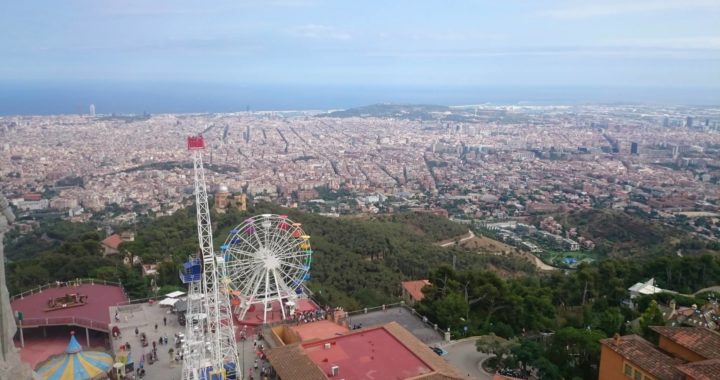THE MOUNTAIN
When some tourists grow tired of the architecture and get a little bored of museums, many opt to go to the beach or picnic in a park, but there is another way to get out of the hustle and bustle of the city center: Tibidabo.
The Serra de Collserola is a mountain range lying between the Besos and Llobregat rivers. It forms a part of the Catalan Coastal Range that snakes its way through Catalonia. Tibidabo is the tallest of the Serra de Collserola mountains, towering at 512m (1,680 ft) over the north-west of Barcelona and offering stunning views of both the cityscape and the coastline.
The name of the mountain comes from Latin Vulgate Bible verses. “Tibi dabo”, meaning “I will give to you” was said to the devil by Jesus as they looked down from a mountain upon all the kingdoms of the world. Of course, oral tradition suggests that this mountain was that same mountain in the Bible, which gives Barcelona’s mountain its name.
GETTING THERE
Tibidabo Funicular was the first funicular railway constructed in Spain, opened over a century ago in 1901. The last renovation of the railway occurred in 1958, giving the railway an quaint, antique vibe (perhaps it needs a touch-up, but it still runs just fine). The Funicular climbs 1102m up a hill with a gradient of over 25%, right to the top of Tibidabo in just a few short minutes.
The Tibidabo Funicular departs from the Plaça del Dr. Andreu (accessible via Bus 196 or the Tramvia Blau, though the tram is more expensive). You can also walk to the Plaça, which should take around half an hour.
As for prices, the Funicular is actually cheaper if you buy a combined ticket for the Theme Park at the top. It costs €4 for a combined ticket (this just being for the funicular, with the park admission fee on top), and €7.50 without buying a ticket for the Theme Park. The railway opens 15 minutes before the Camí del Cel ride opens in the Theme Park and closes 15 minutes after the ride shuts.
But once you’re up there, what is there to see and do?
BASÍLICA DEL SAGRAT COR DE JESÚS
Located above the top funicular station stands an incredible basilica. As you may be able to tell from the name, this was Barcelona’s answer to the Parisian Sacré-Coeur. However, this basilica is actually two churches built right on top of each other. The top church is presided over by a huge statue of Jesus Christ.
The interior of the ground floor is a neo-byzantine style crypt, but the upper level is where you can find the actual church. Architecture is a blend of Roman and Gothic style, with hints of Modernist influence.
There is a lift to take you to the top of the church for panoramic views even higher than the mountain, costing €3.50 for the ride up. Be cautioned though, because it can get very windy up there!
TORRE DE COLLSEROLA
This 288m-high telecommunications tower was completed in 1992. For €5.60 for adults and €3.30 for children, visitors can be whisked up to the observation area (at 115m) in an external glass lift for tremendous views. On a clear day,
views extend 70km, and tourists can sometimes spot Montserrat in the distance.
Barcelona’s TV and radio are transmitted from this very tower.
Getting to the tower is a little way away from all the other Tibidabo attractions but can be accessed via Bus 111 from the mountain funicular station.
PARC DE COLLSEROLA
Nearby the tower, the Parc the Collserola offers a green retreat in the hills. The 80-sq-km park has plenty of places to snack and grab a coffee, relax, or hike and bike. There are also a few country chapels dotted throughout the park, as well as the Castellciuro Castle ruins in the west, several lookout points and Can Coll, a grand farmhouse in the north.
Now, Can Coll is an environmental education centre. For another education experience, check out the Villa Joana to learn about a great writer from Barcelona’s 19th Century.
Something to note, however, is that the park is closed from late June to early September.
TIBIDABO AMUSEMENT PARK
Closer to the funicular station is the Tibidabo Amusement Park. An entrance ticket to the park will set you back €28.50, or €12.50 if you just want access to the panoramic area. This is a very old-school theme park, featuring over 25 rides in a mixture of old-style classics and white-knuckle adventures. The park was opened in 1905, making it a real institution in Barcelona; it has been entertaining families for over 100 years.
The Ferris Wheel offers great views from the mountain, and children can enjoy the Choo-Choo Train or Log Flume rides. There is also a 1928 Avio propeller plane, somewhat of an iconic ride in the park as it soars skyward with its visitors tucked safely inside.
For bigger daredevils, there is the Muntanya Russa coaster that screams through the woods at more than 80kph, 500m above sea level.
FABRA OBSERVATORY
Designed by Joseph Domenech i Estapa, the Fabra Observatory was built in 1901. The observatory carries out research into meteorology, seismology and astronomy, just as it has done for over a century now. Located 413m above sea level and nestled amongst the pines, this is a great building to pay a visit to on your trip to Tibidabo.
Although it is not actually in Tibidabo, it is very close by and definitely worth a visit. Barcelona has one of the clearest skies in the world (300 days of sunshine per year), making it an excellent place for stargazing. You will need to walk a way to get there, but the observatory is open to the public every Sunday from 11am to 2pm, at the price of just €2. The botanical gardens and outdoor gazebo viewpoint are also open on Sundays at this time and are free to explore.
